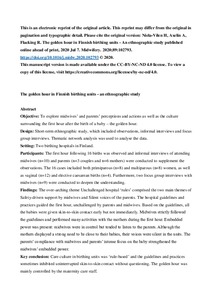The golden hour in Finnish birthing units - An ethnographic study
Axelin Anna; Flacking Renée; Niela-Vilen Hannakaisa
https://urn.fi/URN:NBN:fi-fe2021042825555
Tiivistelmä
Objective: To explore midwives’ and parents’ perceptions and actions as well as the culture surrounding the first hour after the birth of a baby –the golden hour.
Design: Short-term ethnographic study, which included observations, informal interviews and focus group interviews. Thematic network analysis was used to analyse the data.
Setting: Two birthing hospitals in Finland.
Participants: The first hour following 16 births was observed and informal interviews of attending mid- wives ( n = 10) and parents ( n = 3 couples and n = 6 mothers) were conducted to supplement the observations. The 16 cases included both primiparous ( n = 8) and multiparous ( n = 8) women, as well as vaginal ( n = 12) and elective caesarean births ( n = 4). Furthermore, two focus group interviews with midwives ( n = 9) were conducted to deepen the understanding.
Findings: The over-arching theme Unchallenged hospital ‘rules’ comprised the two main themes of Safety-driven support by midwives and Silent voices of the parents. The hospital guidelines and practices guided the first hour, unchallenged by parents and midwives. Based on the guidelines, all the babies were given skin-to-skin contact early but not immediately. Midwives strictly followed the guidelines and performed many activities with the mothers during the first hour. Embedded power was present: midwives were in control but tended to listen to the parents. Although the mothers displayed a strong need to be close to their babies, their voices were silent in the units. The parents’ compliance with midwives and parents’ intense focus on the baby strengthened the midwives’ embedded power.
Key conclusion: Care culture in birthing units was ‘rule-based’ and the guidelines and practices sometimes inhibited uninterrupted skin-to-skin contact without questioning. The golden hour was mainly controlled by the maternity care staff.
Implications for practice: Re-evaluation of hospital guidelines should enable more woman- and family- centred care. The golden hour is unique to families, and unnecessary separation and interventions should be avoided.
Kokoelmat
- Rinnakkaistallenteet [19218]
